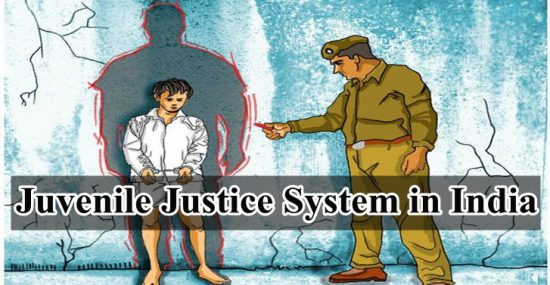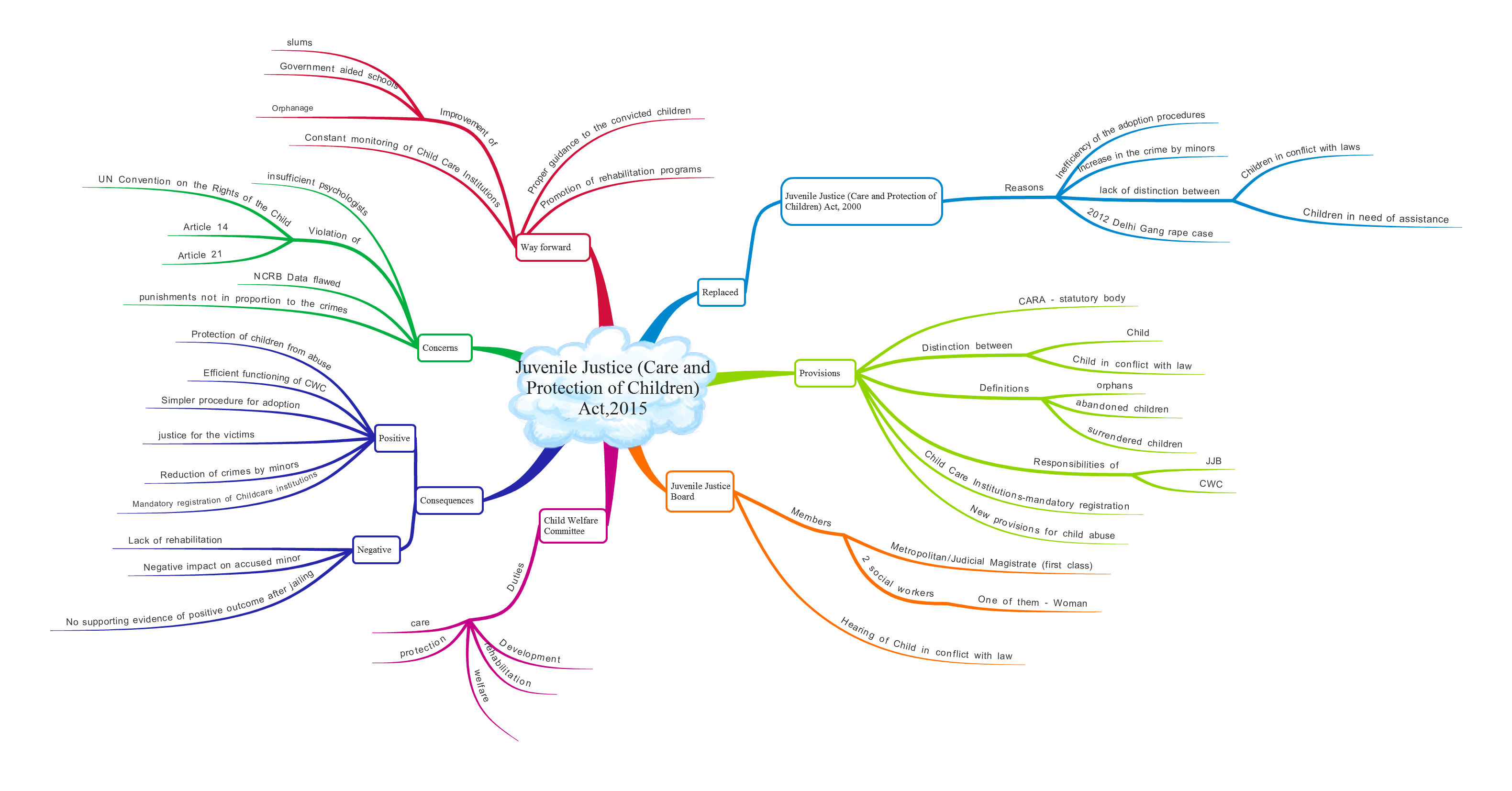Juvenile Justice (Care and Protection of Children) Act – Explained

From Current Affairs Notes for UPSC » Editorials & In-depths » This topic
IAS EXPRESS Vs UPSC Prelims 2024: 80+ questions reflected
Updates *
The Juvenile Justice (Care and Protection of Children) Act, 2015 was passed by both houses of parliament and came into effect on 15 January 2016. This act was under public scrutiny because of the provision that provided for the consideration of the 16-18 year olds as adults in case of them indulging in heinous crimes.
What does this Act contain?
- This act replaces Juvenile Justice (Care and Protection of Children) Act, 2000.
- The key provisions of this Act include:
- Change in the nomenclature from “juvenile” to “Child” and Child in conflict with the law”.
- It provides definitions for orphaned, abandoned and surrendered children
- Definitions for petty, serious and heinous crimes committed by the children.
- It provides clarity on the powers, functions, and responsibilities of the Juvenile Justice Board (JJB) and Child Welfare Committee (CWC).
- Organised and efficient system of adoption of orphaned, abandoned and surrendered children.
- Provision for the inclusion of new offences that are committed against children. These offences are not included in any other laws in India.
- This act makes it mandatory for all the Child Care Institutions to be registered.
- It allows minors in the age group of 16-18 to be tried as adults if they commit heinous crimes after JJB examines the crime to determine whether the crime was committed as an adult or a child.
- It provides special provision that gives JJB, after preliminary assessment, an option to shift those children who are between the ages of 16 and 18 who commit heinous crimes to Children’s Court (Court of Session).
- Central Adoption Resource Authority (CARA) is given statutory status.
Who is a juvenile?
- Juvenile is any individual below the age of 18.
- In India, no child below the age of 7 can be convicted under any laws.
- The distinction of children who are in conflict with law and children who are in need of aid were both termed juvenile, making it vague and difficult to be distinguished.
- Therefore in the amended law, the terms “child in conflict with law” and “children in need of care and protection” was included.
Why was the Juvenile Justice (Care and Protection of Children) Act, 2000 replaced?
- The inefficiency of the adoption procedures.
- Increase in the crime committed by children between the ages of 16 to 18. According to National Crime Record Bureau, the heinous crimes committed by this age group have increased from 54% to 66% between 2003-2013.
- There were no distinctions between Children who are in conflict with law and children who are in need of care and protection. The Juvenile Justice (Care and Protection of Children) Act, 2015 provides a distinction between these children.
- Provisions are provided in the amended law to both the above-mentioned categories of children.
- This amendment is in response to the infamous 2012 Delhi Gang rape case when the accused was a few months younger than 18 years was tried under juvenile justice board and was sentenced for 3 years in a reform home.
- This law seeks to create a balance between justice and Child Rights by not providing life imprisonment and the death penalty for the juveniles.
What are the Juvenile Justice Board and the Child Welfare Commission?
- Juvenile Justice Board is a judiciary body involved in discharging powers and functions related to hearing of Children in conflict with the law.
- The cases in JJB are heard by a bench consisting of Metropolitan Magistrate or a Judicial Magistrate of first class with at least three years of experience, social workers among whom one of them should be a woman.
- Child welfare committee is involved in discharging duties related to cases that involve in care, protection, treatment, development, and rehabilitation of children who are in need of care and protection.
What are the consequences of Juvenile Justice (Care and Protection of Children) Act, 2015?
Positive:
- This law provides for the efficient functioning of CWC.
- It aims to reduce the crimes committed by minors between the ages of 16 and 18
- It will provide sound justice to the victims while at the same time safeguards children’s rights.
- It brings all the registration of Childcare in Institutions, thus allow transparency of their functioning.
- Children are protected from crimes committed against them.
Negative:
- This law could cause an adverse effect of the convicted minors.
- According to many psychological studies, the ages of 16-18 is when there is actual vulnerability due to hormonal and physical changes resulting in adolescent crimes. Considering these minors as criminals and jailing them would bring them into contact with the professional criminals who are already residing there. They might suffer or learn new and illegal ways leading them to become future liabilities.
- There are no supporting cases anywhere that gave jailing of minors a positive outcome.
- Those children who are jailed will have difficulty in mingling with society and will suffer the rest of their lives. Rehabilitation, on the other hand, will give them a fresh start.
Why the concern over the amended law?
- Violation of article 14: The amended law will be in contradiction to Article 14 of the Indian Constitution that provides the Right to Equality as the minors between the ages of 16-18 are not treated equally.
- Violation of UN Convention on the rights of the child: UN Convention on the Rights of the Child was ratified by India in 1992. According to this convention, all individuals below 18 are children. This amended law gives special provisions for considering those between ages 16-18 as adults.
- Lack of sufficient psychologists: The provision in the Act that provides for the use of Psychologists to determine whether the child is fit to be considered as an adult is not based on the Rule of Law. The field of Psychology is in itself vague and not scientific. Also, there aren’t sufficient psychologists in the country.
- Violation of Article 21: This law is in violation of the right to life and liberty as the children’s rights are in the hands of the juvenile Justice Board with little to no information on the proceedings.
- Flawed NCRB data: This amendment was made on the basis of data given NCRB. However, most of these cases were in the FIR stage and many cases were under preliminary proceedings.
- Vague and unjustified: Some provisions that provide punishments to child abuse are not in accordance to the gravity of the crime.
Way Forward:
- Most children who commit these crimes are from a poor background. They are unaware of the consequences. Punishing them instead of promotion of rehabilitation will do little to improve the future society.
- The Government must improve the Child Care Institutions to provide a better environment for the child’s growth and development.
- Improvement of the slum areas and government-aided schools through infrastructure development to reduce the crimes committed by the minors.
- This law provides an efficient mechanism for providing the needs of those children who are in need of care and protection. However, continuous monitoring of its functioning is essential to maintain and improve the efficacy of the same.
Juvenile Justice Act and Detention of Minors *
If you like this post, please share your feedback in the comments section below so that we will upload more posts like this.



